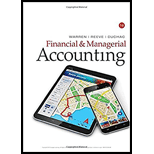
Concept explainers
Internal Control: Internal control refers to the policies, and plans of the business organization along with other measures with a view to safeguard its assets, encourage the employees to adhere to the plans, to improve on the operational efficiency, and to ensure correct and reliable accounting information. Internal control is a process which ensures continuous reliability of accomplishment of a company’s objectives, related to operations, financial reporting, and in conformity with laws and regulations.
The following are the some of the internal control procedures:
- Competent personnel, rotating duties, and mandatory vacations
- Separating responsibilities for related operations
- Separating operations, custody of assets, and accounting
- Proofs and security measures
To describe: The internal control procedure that will prevent or detect fraud.
Want to see the full answer?
Check out a sample textbook solution
Chapter 7 Solutions
Bundle: Financial & Managerial Accounting, Loose-Leaf Version, 14th + CengageNOWv2, 2 terms Printed Access Card
- Not need chart gpt solution please given answer general accounting questionarrow_forwardHelp me with thisarrow_forwardA wealthy investor is considering purchasing a perpetual annuity that pays $1.8 million per year indefinitely. If the required rate of return is 5.2%, what is the present value of the investment?arrow_forward
- What is your firms beginning cash balance on september 1 ? General accounting questionarrow_forwardOption? General accounting questionarrow_forwardBlue Ridge Logistics acquired a truck for $75,000 at the beginning of the year. The truck has a useful life of 8 years and an estimated salvage value of $7,000. Compute the annual depreciation expense using the straight-line method.arrow_forward
 Auditing: A Risk Based-Approach (MindTap Course L...AccountingISBN:9781337619455Author:Karla M Johnstone, Audrey A. Gramling, Larry E. RittenbergPublisher:Cengage Learning
Auditing: A Risk Based-Approach (MindTap Course L...AccountingISBN:9781337619455Author:Karla M Johnstone, Audrey A. Gramling, Larry E. RittenbergPublisher:Cengage Learning
